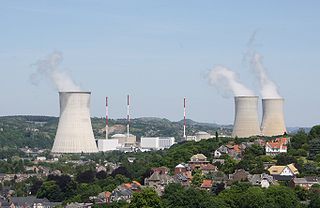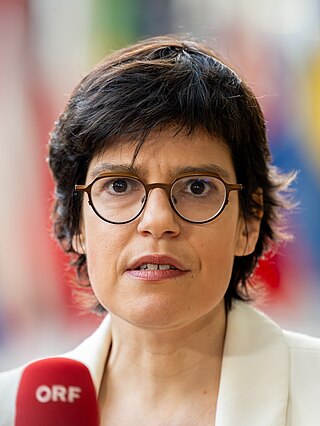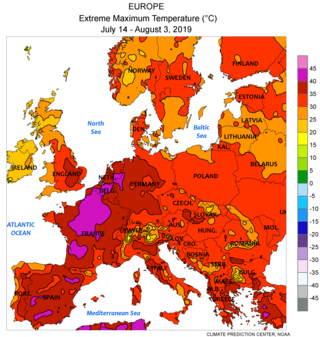
SCK CEN, until 2020 shortened as SCK•CEN, is the Belgian nuclear research centre located in Mol, Belgium. SCK CEN is a global leader in the field of nuclear research, services, and education.

The Alvin W. Vogtle Electric Generating Plant, also known as Plant Vogtle, is a four-unit nuclear power plant located in Burke County, near Waynesboro, Georgia, in the southeastern United States.

A nuclear power phase-out is the discontinuation of usage of nuclear power for energy production. Often initiated because of concerns about nuclear power, phase-outs usually include shutting down nuclear power plants and looking towards fossil fuels and renewable energy. Three nuclear accidents have influenced the discontinuation of nuclear power: the 1979 Three Mile Island partial nuclear meltdown in the United States, the 1986 Chernobyl disaster in the USSR, and the 2011 Fukushima nuclear disaster in Japan.

Nuclear energy policy is a national and international policy concerning some or all aspects of nuclear energy and the nuclear fuel cycle, such as uranium mining, ore concentration, conversion, enrichment for nuclear fuel, generating electricity by nuclear power, storing and reprocessing spent nuclear fuel, and disposal of radioactive waste. Nuclear energy policies often include the regulation of energy use and standards relating to the nuclear fuel cycle. Other measures include efficiency standards, safety regulations, emission standards, fiscal policies, and legislation on energy trading, transport of nuclear waste and contaminated materials, and their storage. Governments might subsidize nuclear energy and arrange international treaties and trade agreements about the import and export of nuclear technology, electricity, nuclear waste, and uranium.

Electrabel SA is a Belgian energy corporation. It is a subsidiary of French multinational utility company Engie S.A..
Nuclear power in Switzerland is generated by three nuclear power plants, with a total of four operational reactors (see list below). Nuclear power has contributed a steady fraction of around forty percent to the Swiss electricity production since 1985. In 2022, it produced 23 terawatt-hours (TWh) of electricity, and accounted for 37% of the nation's gross electricity generation of 62 TWh, while 55% was produced by hydroelectric plants and 8% came from conventional thermal power stations and non-hydro renewable energy sources.

The Beznau nuclear power plant is a nuclear power plant of the Swiss energy utility Axpo, located in the municipality Döttingen, Canton of Aargau, Switzerland, on an artificial island in the Aare river. The plant has been operating since September 1969.

The Tihange Nuclear Power Station is one of two nuclear energy power plants in Belgium and contains three nuclear reactors. The site is located on the bank of the Meuse river, near the village of Tihange in the Walloon province of Liège. The station is operated and majority-owned by vertically-integrated Belgian energy corporation Electrabel. EDF Luminus has a 50% stake in the oldest unit and a 10% stake in the two newest units. It employs 1074 workers and covers an area of 75 hectares. The plant represents about 15% of Belgium's total electricity production capacity. Nuclear energy typically provides between 40%-50% of Belgium's domestically-generated electricity. In order to extend the lifetime of Tihange 3, the operator will receive subsidies through a Contract of Difference arrangement.
The three primary objectives of nuclear reactor safety systems as defined by the U.S. Nuclear Regulatory Commission are to shut down the reactor, maintain it in a shutdown condition and prevent the release of radioactive material.

Energy in Belgium describes energy and electricity production, consumption and import in Belgium.

Tinne Van der Straeten is a Belgian politician who has been serving as Minister of Energy in the De Croo Government since October 2020. She is a member of the Groen party. She previously served in the Chamber of Representatives for Brussels-Halle-Vilvoorde from 2007 to 2010 and later for Brussels from 2019 until 2020, when she resigned to become energy minister.

The Fukushima nuclear accident was a major nuclear accident at the Fukushima Daiichi nuclear power plant in Ōkuma, Fukushima, Japan which began on March 11, 2011. The proximate cause of the accident was the 2011 Tōhoku earthquake and tsunami, which resulted in electrical grid failure and damaged nearly all of the power plant's backup energy sources. The subsequent inability to sufficiently cool reactors after shutdown compromised containment and resulted in the release of radioactive contaminants into the surrounding environment. The accident was rated seven on the INES by NISA, following a report by the JNES.

Fukushima Daiichi is a multi-reactor nuclear power site in the Fukushima Prefecture of Japan. A nuclear disaster occurred there after a 9.0 magnitude earthquake and subsequent tsunami on 11 March 2011. The earthquake triggered a scram shut down of the three active reactors, and the ensuing tsunami crippled the site, stopped the backup diesel generators, and caused a station blackout. The subsequent lack of cooling led to explosions and meltdowns, with problems at three of the six reactors and in one of the six spent-fuel pools.
Belgium has two nuclear power plants operating with a net capacity of 5,761 MWe. Electricity consumption in Belgium has increased slowly since 1990 and in 2016 nuclear power provided 51.3%, 41 TWh per year, of the country's electricity.

Belgium has the 7th largest CO2 emission per capita in the EU. The CO2 emissions have dropped 19.0% since in comparison with 1990 levels. The average temperature has risen 1.9 degrees Celsius since measurements began in 1890, with an acceleration since 1954.
The Fukushima disaster cleanup is an ongoing attempt to limit radioactive contamination from the three nuclear reactors involved in the Fukushima Daiichi nuclear disaster that followed the earthquake and tsunami on 11 March 2011. The affected reactors were adjacent to one another and accident management was made much more difficult because of the number of simultaneous hazards concentrated in a small area. Failure of emergency power following the tsunami resulted in loss of coolant from each reactor, hydrogen explosions damaging the reactor buildings, and water draining from open-air spent fuel pools. Plant workers were put in the position of trying to cope simultaneously with core meltdowns at three reactors and exposed fuel pools at three units.

The Fukushima Daiichi reactor, was 1 out of 4 reactors seriously affected during the Fukushima Daiichi nuclear disaster on 11 March 2011. Overall, the plant had 6 separate boiling water reactors originally designed by General Electric (GE), and maintained by the Tokyo Electric Power Company (TEPCO). At the time of the earthquake, Reactor 4 had been de-fueled while 5 and 6 were in cold shutdown for planned maintenance.

The Fukushima Daiichi reactor, was 1 out of 4 reactors seriously affected during the Fukushima Daiichi nuclear disaster on 11 March 2011. Overall, the plant had 6 separate boiling water reactors originally designed by General Electric (GE), and maintained by the Tokyo Electric Power Company (TEPCO). At the time of the earthquake, Reactor 4 had been de-fueled while 5 and 6 were in cold shutdown for planned maintenance. Unit 1 was immediately shut down automatically after the earthquake, and emergency generators came online to control electronics and coolant systems. However, the tsunami following the earthquake quickly flooded the low-lying rooms in which the emergency generators were housed. The flooded generators failed, cutting power to the critical pumps that must continuously circulate coolant water through the reactor core. While the government tried pumping fresh water into the core, it was already too late due to overheat. In the hours and days that followed, Unit 1 experienced a full meltdown.

The Fukushima Daiichi reactor, was 1 out of 4 reactors seriously affected during the Fukushima Daiichi nuclear disaster on 11 March 2011. Overall, the plant had 6 separate boiling water reactors originally designed by General Electric (GE), and maintained by the Tokyo Electric Power Company (TEPCO). In the aftermath, Unit 3 experienced hydrogen gas explosions and suffered a partial meltdown, along with the other two reactors in operation at the time the tsunami struck. Reactor 4 had been de-fueled while 5 and 6 were in cold shutdown for planned maintenance.

















